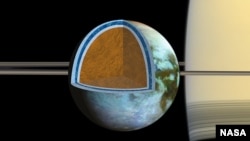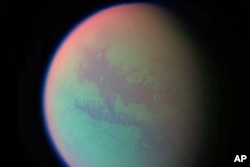New research casts doubt on the possibility of finding life as we know it on Saturn’s moon, Titan. The giant ocean believed to exist below the moon’s surface has long been thought a place where life could exist.
But gravity and topography data collected during the Cassini spacecraft's repeated flybys of Titan data led to an “improved understanding of the structure of the moon’s outer ice shell” and the ocean below.
In a paper published earlier this month, NASA researchers say they have found evidence that the ocean could be “as salty as Earth’s Dead Sea.”
Researchers point out that by salty, they don’t just mean sodium chloride.
Titan's extremely salty brine appears to be watery mix of sulfur, sodium and potassium, said the paper's lead author, Giuseppe Mitri of the University of Nantes in France in an email.
"This is an extremely salty ocean by Earth standards," said Mitri in a statement. "Knowing this may change the way we view this ocean as a possible abode for present-day life, but conditions might have been very different there in the past."
He added that the discovery indicates “there was direct interaction between Titan’s deep interior and the subsurface liquid water during its past history with interesting implications for its habitability.”
Using data from the Cassini spacecraft, researchers studied the variations in Titan’s gravitational field, researchers were able to determine that the subsurface ocean had to be highly dense with a salt content “roughly equal to the saltiest bodies of water on Earth.”
Topography data also revealed that the moon’s shell is in the process of freezing solid. Variations in the thickness of the shell also point to the subsurface ocean slowly freezing.
"Titan continues to prove itself as an endlessly fascinating world, and with our long-lived Cassini spacecraft, we're unlocking new mysteries as fast as we solve old ones," said Linda Spilker, Cassini project scientist at NASA's Jet Propulsion Laboratory in Pasadena, California, in a statement. She was not involved in the study.
The findings are published in this week's edition of the journal Icarus.









